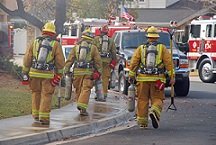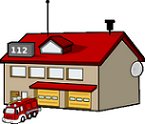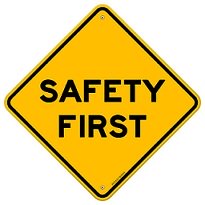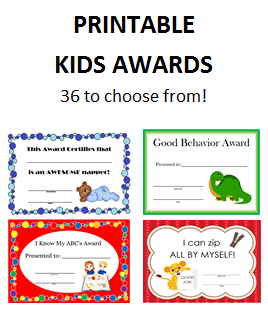Storm and Fire Safety
Practice Drills for Children’s Safety
Storm and Fire Safety is an important part of daycare safety. All licensed home based daycare's must have emergency plans in place in the event a storm or fire occurs.

All children should have basic knowledge of storm and fire safety to feel less fearful and be able to help themselves.
All drills should be taken seriously so you are able to protect the children in your care should there be an actual storm or fire.
Fire plans must include two exits out of every room, having a fire extinguisher on the premises, knowing how to use it and having an agreed upon meeting place outside.
Storm drills must include a safe area in your home (preferably in a lower level without windows), flashlights or lanterns and a battery operated radio.
Daycare Storm and Fire Safety
Once my children were old enough, I taught them that if they hear a big alarm “in the house”, they need to get outside. If they hear a siren “outside”, they need to stay in the house.
In the event of an emergency the key to survival is being prepared. Storm and fire safety should be practiced on a regular basis. Here are some tips for both storm and fire safety.
Tips for Storm Drills with Children:
Make sure you have flashlights/lanterns and a portable radio. Replace batteries when needed to insure all products are working properly.
Unlike a fire, you HIDE during a storm.

Practice the storm drills frequently so that simple commands will instantly be obeyed. Our hiding spot is an empty area underneath the stairs in the basement. My kids learned that the command "Get Down!" meant to crouch down (knees and elbows) facing the interior wall. Teach children to place their arms over the back of their head. The simple command "Cover your head", then tells them what to do.
Teach children that in the event of a bad storm the power may go out and it may be dark.

Even during drills you should use the radio to hear weather reports. You want the drill to be as close to the real thing as possible. Let the children know they are not allowed to move until you know an all clear has been issued. Sometimes it won't be too long and other times it may take a while.
Once you have an all clear, teach children that they may have to be careful when leaving the storm area. Depending on any actual damage to your home, there may be clutter, broken glass, etc. that they have to be very careful around.
Never use your storm drill area for anything else. The area should be free of clutter at all times. In the event of an actual storm there won't be time to clean out or rearrange the area.
Time each drill. When the emergency signal sounds in your area, you may have only seconds to get to your safe place.
Watch children’s videos or read children’s books on storm safety.

Make sure you actually set off the alarm during the drill. Children need to become familiar with the sound. Yes, it's loud, but it serves a purpose. Drills using the alarm noise help to reduce the feeling of panic that can arise if a fire actually breaks out.
The most important thing to teach about fires is that when the alarm goes off; do not stop for any reason. Children need to be taught that even if the weather is bad outside, they should not stop for a coat or shoes, or try to take along a special toy.
Teach children how to open windows and remove screens. My older kids actually loved the fire drills since it was the only time I allowed them to jump out the windows. I also let them know that should they have to, the screens are weak and can be easily kicked out with their foot. I demonstrated this with an old screen. Children need to be taught that in the event of an actual emergency they have the right to kick out screens and break windows if necessary to get out, and they will not get in trouble for it.
Have the children practice both walking out, and crawling. Teach that both heat and smoke rise and the safest place is close to the floor. Also teach that doors need to be checked before they are opened. Check the door closer to the top, using the same theory that heat rises.
Make certain that any and all escape routes are free of clutter. You don't want children to have to maneuver around objects or move items in an attempt to escape.
Practice fire drills over and over using a variety of exits. The more they practice the more in control the children will feel. We also practiced having the bigger kids jump out the window first, and having the younger ones lifted out by me to be grabbed by the older ones. After a couple of times, the younger kids not only had no fear of going out the window, they actually thought it was fun.
Let children know that in the event of a real fire, it may be dark, smoky, and hot. Children need to know exactly what to expect along with exact instructions on what to do.
Make sure all the children understand EXACTLY where the meeting place outside is. Let them also know that once they are out, to STAY out.
Teach the STOP-DROP-ROLL technique. Let them practice many times.

Take a trip to the fire station, or have a fireman visit your daycare. The children should be able to see a fireman up close. Children are less afraid of things they have previously experienced. Let them know in the event of a real fire, they should NEVER hide (unlike a storm). Let them know that a fireman will help them IF the fireman knows where they are. Teach them they can grab the leg of the fireman when they see one.
Read books or watch videos on fire safety or fire prevention.
Time each drill. Get a stopwatch so you are aware of exactly how fast everyone exits the building. Your goal should be to have your home evacuated in less than two minutes.
Practice both storm and fire safety monthly. Keep a record of drills (some states require this) with my Storm and Fire Drill Log. Storm and fire safety needs to be an on-going process. Children always learn best through repetition.
_________________________________________________________________

As a child care provider, your top priority is the safety of the children. PLEASE... take the time to look over the entire safety section.
- Extra Safety Tips specific to Child Care Providers
- Common household items that pose a danger to children: Some you may have never considered.
- Daycare Regulations for safety: A must read.
- Child Gun Safety: Even if you don't own a gun, your daycare children may be exposed to guns in the homes of friends or relatives.
- Poisonous Plants: We all have plants. You'll need to know which ones pose a problem for children.
- Home Chemical Safety: The precautions you need to take.
- Daycare Emergencies: You should always be prepared.
Storm and fire safety is one small part of daycare safety. Learn all you can to keep the children as safe as possible.
_________________________________________________________________
from storm and fire safety to safety main page
from storm and fire safety to simply daycare home












